Later this year, one of the UK’s most sustainable office buildings is opening its doors in Finzels Reach. Occupying nearly two thirds of the seven-storey modern marvel is international law firm, Osborne Clarke. As it prepares to move its 600-strong team into the new build, we sit down with the head of the Bristol office, Lara Burch…
Four years in the making and one of the UK’s most sustainable office buildings is about to open its doors in Bristol’s award-winning Finzels Reach. Designed with people and business in mind, the landmark seven-floor 116,113 sq ft Grade A office development, which has been constructed on the former site of Avon Fire & Rescue, will house around 1,000 staff members from occupiers including international legal firm, Osborne Clarke. The Bristol founded law firm will relocate its 600-strong team from its Temple Quay office into the smart workspace, occupying the top five of seven floors, including the private roof terrace.
The development, known as Halo, is setting new standards of sustainability for offices in Bristol and beyond. Property developer and urban regenerator Cubex, which bought the site in the summer of 2018 on behalf of Fiera Real Estate Opportunity Fund IV (UK), worked hard to ensure Halo met the tough new sustainability assessment criteria. As a result, Halo is set to be awarded a BREEAM Outstanding 2018 sustainability accreditation.
In addition to its stand-out environmental credentials, the development also features cutting-edge digital connectivity – recognised with the highest ‘Wired’ Platinum score. What’s more, Halo has been designed to prioritise the wellbeing of its occupants and will be one of the UK’s first properties to achieve WELL Core Building certification.
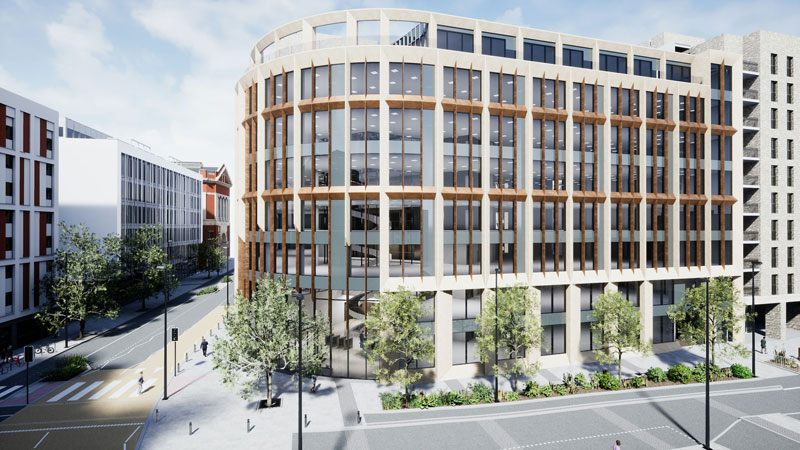
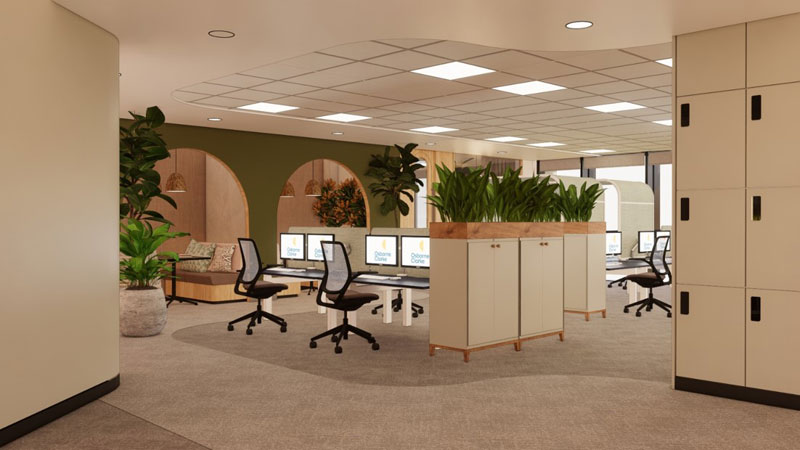
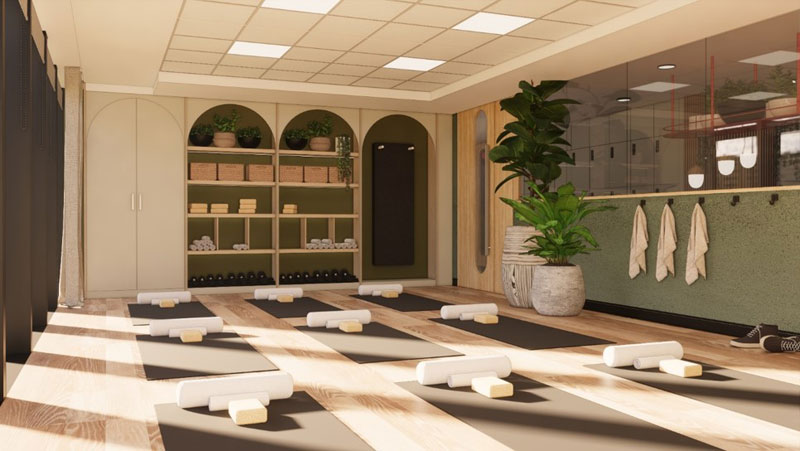
Finzels Reach: a thriving new neighbourhood
Finzels Reach has seen massive development in recent years. Located in central Bristol, a stone’s throw from the floating harbour and in walking distance from Cabot Circus and Temple Meads, it was once home to one of the largest sugar refineries in England. Now, over 3,000 people live and work in the 4.7-acre mixed-use community. Renowned national and international companies have set up permanent residence, including Channel 4, Historic England and English Heritage, Simmons & Simmons, Barclays, EDF and Bafta-winning BDH Creative.
Most notably, Bristol’s first BREEAM Outstanding 2014 commercial office space, Aurora, is situated directly opposite the new build, perfectly mirroring Halo’s spectacular seven-storey glass atrium. The city’s first Build to Rent scheme, Hawkins and George, is also just a few steps away.
Osborne Clarke: the leading technology law firm
Osborne Clarke has a long history in Bristol, stretching back to 1748. September 2019 marked 50 years since two of the oldest law firms in Bristol – Osborne Ward and Clarke Gwynn & Press – merged to create the firm it is today. From the very beginning, however, Osborne Clarke has been embedded within the local community, engaging in what would now be called environmental, social, and governance activity. Ahead of Halo’s official opening, we had the pleasure of sitting down with the head of Osborne Clarke’s Bristol office, Lara Burch. We chatted to her about how the development’s modern features will not only complement the future-focused brand, but cement its reputation as being a leading technology law firm. It was, after all, one of the UK’s first law firms to open an office in Silicon Valley 20 years ago.
“ESG is a key pillar of our 2025 strategy,” says Lara. “We’ve always had a culture of giving and we are now making that a central part of our strategy as a business, alongside our continued determination on minimising our environmental impact.”
Halo: sustainability at its heart
A corkscrew-like staircase rises up through the grandly proportioned multi-floor lobby, natural light floods the open spaces and an expansive glazed façade creates an instant spectacle in the neighbourhood. Halo indubitably offers a refined refuge from the urban flow. What makes this sustainable development so fascinating, however, is that every detail has been so carefully considered. Energy is regenerated from descending lifts and roof-mounted solar panels, reducing the building’s demand for grid electricity. Water consumption is minimised through the harvesting of rain water. Air quality is improved by a ventilation system that supplies 20% fresher air than is required by building regulations.
Halo has also been connected to Bristol’s low-carbon district heating network to drastically reduce its dependence on fossil fuel. Already, it adds up to a compelling mix, and that’s before we’ve even delved into the other aspects of the extensive spec list. The sustainability of the construction’s materials and internal fixtures have all been meticulously studied and evaluated. Osborne Clarke’s designers, Interaction, has looked at how far materials have travelled, the environmental impact of producing those materials, and the impact they have on the health and wellbeing of the people who will be using the building. Paint finishes have even been chosen for their lower chemical content, so they contribute to high standards of air quality inside the building. Many of the soft furnishings have been made from recycled textiles; and some of the lampshades in the collaborative work spaces have even been made using the orange peel from the orange juice producer.
Durability and repairability were also important criteria for the products that appear in the new space. Where practical, Osborne Clarke has opted for bamboo instead of wooden furniture because of its ability to renew more quickly. Where wood is being used in the building, it is FSC-certified so the company knows it comes from forests that are managed to strict environmental, social and economic standards. Halo, ultimately, radiates the feel-good factor.
“Our lease on our current office location was coming to an end and we had the opportunity to renew or move to another space. We consulted with our people and felt moving to a new location was the best option for us,” explains Lara. “One thing that came from everybody was the focus around sustainability. People might have different views on the colours of the carpets or the style of the chairs but everyone was really focused on wanting the building to be sustainable, demonstrating what we as a group of people believe in. It has been branded as one of the most sustainable buildings in the UK, and our people love that.”
It is also evident that Osborne Clarke’s design work was completed in a post-pandemic world. Meeting rooms have been fitted with specially shaped tables so that staff members who are dialling in remotely can see everyone around the table. Two years on from the first lockdown and we’re still very much craving the tranquillity of the natural world. With this in mind, there is an organic nature to the styling and three living walls have been incorporated into the space.
“We wanted to try and create an environment that people will love,” says Lara. “We’ve put a lot of thought into the spaces, making sure that people are comfortable.”
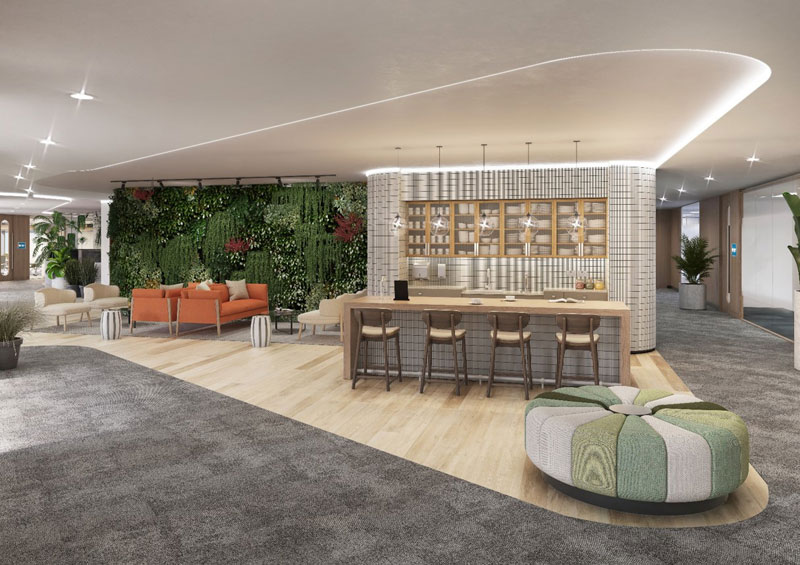
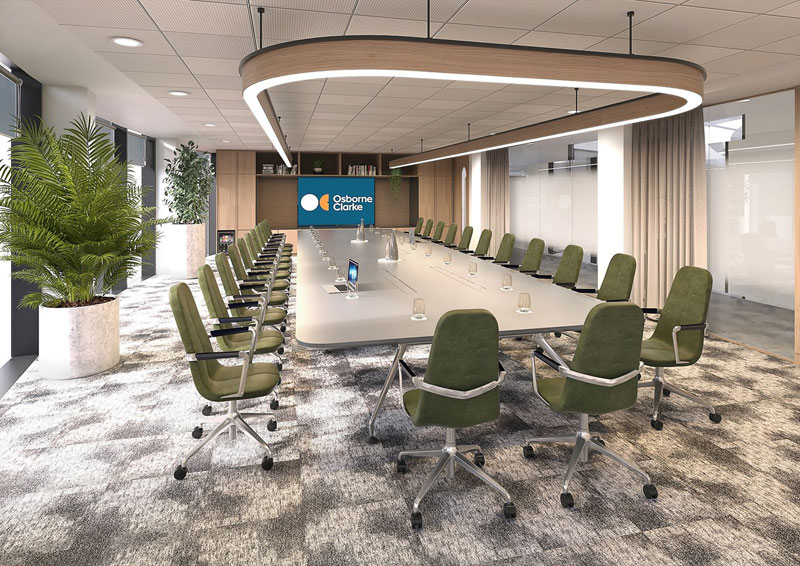
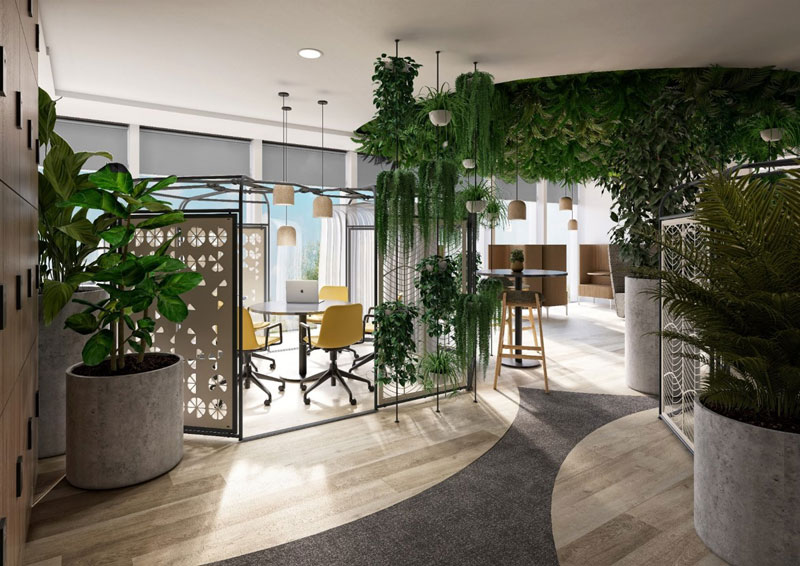
Wellbeing and staff satisfaction
In order for Halo and Osborne Clarke to earn the prestigious WELL certification, they had to deliver more thoughtful and intentional spaces that enhance human health and wellbeing. Before choosing Halo, Osborne Clarke carried out an extensive employee consultation to ensure that any new office met the needs of its people. It held multiple rounds of workshops between its designers and the Bristol office, asking colleagues about their requirements and aspirations for the new space. As a result, a wellbeing room; spin, yoga and pilates studios; spa-quality bathroom facilities; and gender-neutral toilets were all inserted into the plans.
During the build, Osborne Clarke also gave its staff the chance to try out a selection of furniture, which they put on display in the atrium of the Temple Quay office. Staff could test out the potential pieces and vote for which ones they wanted to appear in Halo. The firm also held focus groups to obtain a thorough understanding of what activities different people in different roles did in a typical working week, ensuring that the new build accommodated all needs.
“Our briefing exercise identified that key for people will be the collaborative, team-working and social aspect of the office. The opportunity to meet and work together is really key for a strong culture, so the office will primarily be a space to enable and encourage this.
“Through our consultation process to develop the brief for the new office, we identified a number of key aspirations for our brief including diversity and inclusion, authentically sustainable, health and wellbeing, progressive and tech-enabled, collaborative and social.
“We also wanted to provide spaces which reflect the needs of our clients – whether that’s for meetings, temporary workspace before/after meetings or networking opportunities,” Lara explains.
Looking to the future, Osborne Clarke has ensured that it has incorporated the needs and desires of its young lawyers and staff members. “We want to be as attractive an employer for Millennials as we are for Gen X. Increasingly, we are seeing employees put significant importance on wellbeing and sustainability, and by incorporating these elements into the office we hope to appeal to them.”
“The move is not just about the building, but about culture too. Many of the sustainability features are dependent on the people who will use the building. For more than two decades, the firm has been working hard to reduce its environmental impact through its Sustainable Business Group, recently relaunched as OC Planet. It has a clear objective to represent the employee voice and keep the firm accountable for any commitments it makes in this area,” Lara adds.
Ultimately, credit must go to all involved for producing something with such finesse. As buildings account for nearly 40% of global greenhouse gas emissions, 50% of the world’s energy consumption and 40% of raw materials, it’s a pleasure to see Bristol businesses striving for greener, better ways of working. Welcome to Bristol, Halo.
osborneclarke.com; halo-bristol.com
Building images for illustrative purposes courtesy of Cubex and Interaction | Lara Burch picture courtesy of Harsha Parmar


